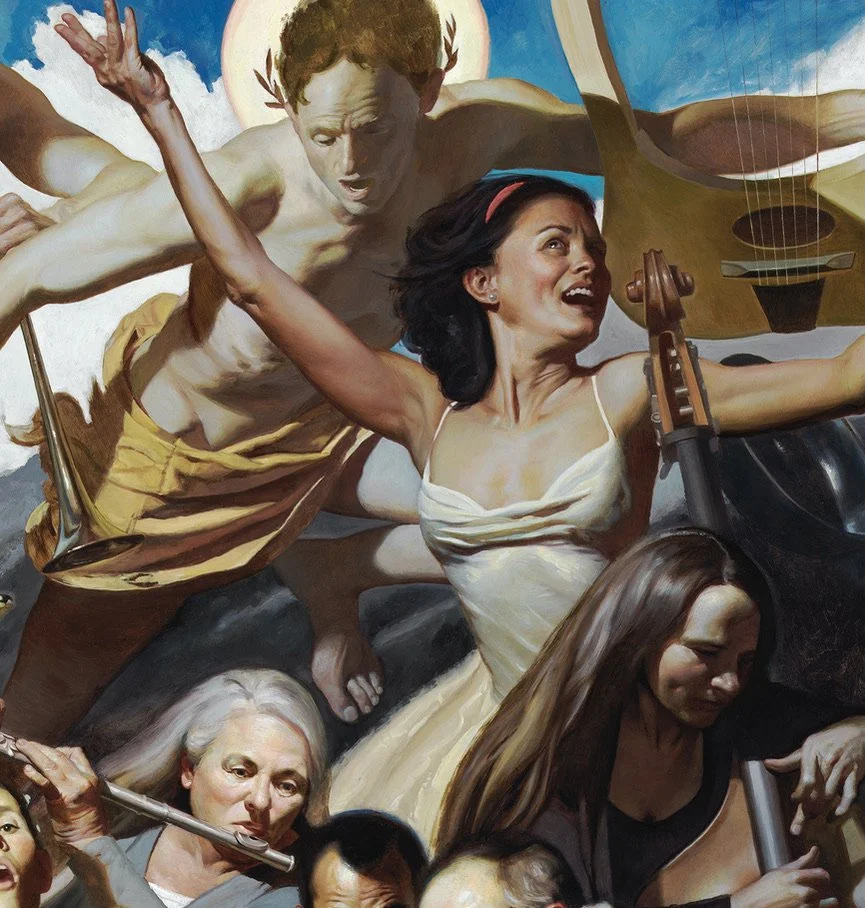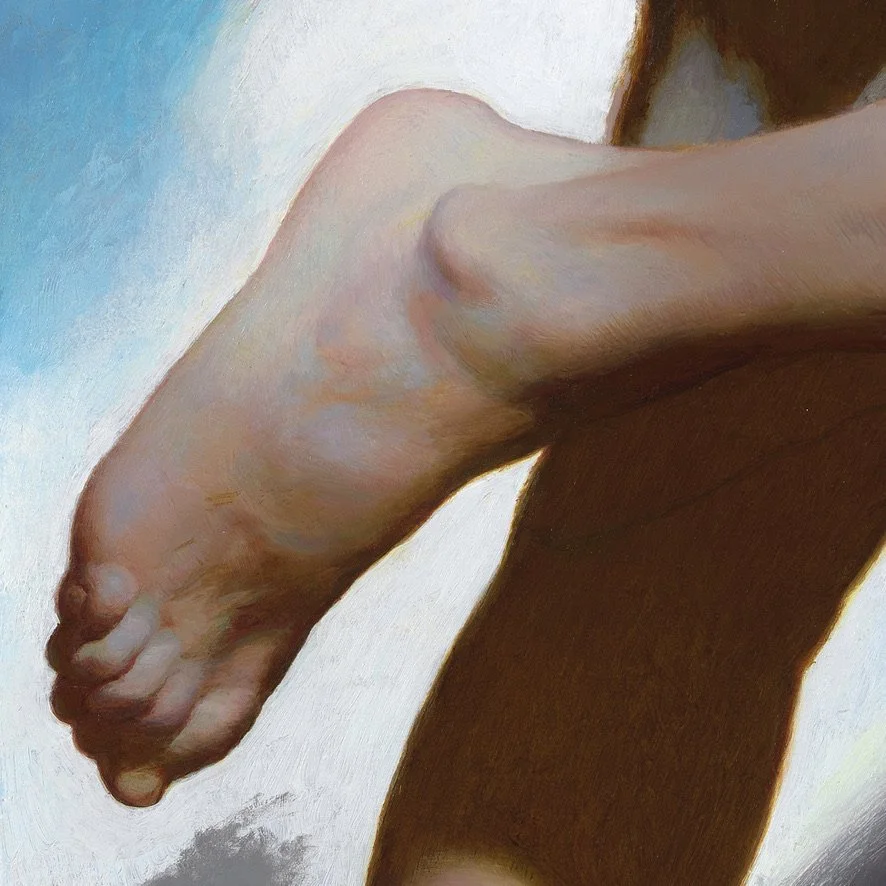Figure Painting: Warm and Cool
Figure Painting: Warm and Cool
15 hour workshop
Instructor: Noah Buchanan
This workshop was recorded and access to it can be purchased below.
This figure painting workshop focuses on the use of color in terms of temperature. The instructor, Noah Buchanan, demonstrates that the effective use of a limited palette divides the artist's conception of color into warms, cools, and neutrals. Buchanan lectures on the temperature zones of the nude figure (local temperatures), the temperature effects of light, and how to determine the correct value of each color.
Workshop artists paint from high-resolution photographs of the nude model, including detailed images of complex areas (head, torso, hands, feet). Workshop participants will create a preliminary drawing, which will be transferred to the canvas (or panel) prior to the beginning of the workshop.
This workshop uses the mode of Direct Painting, where the paint is simply mixed on the palette to the desired value/temperature/color and applied directly to the painting without changing the transparency or opacity of the paint, and without calculating effects from various layers/behaviors of paint.
The Instructor demonstrates these methods/techniques and viewers can follow along. In addition, they have the option for personal critiques for an additional fee.
Registered artists will have access to recordings to review for 30 days after completion.
-
Painting Support:
Primed (gessoed) canvas or panel (medium-smooth, avoid heavy canvas weave or thick brush texture when applying gesso). Pre-stretched canvases should be further gessoed with an additional 3 coats (thin) of gesso and sanded lightly. Oil Primed canvas is also recommended.
The Ground:
Please apply a tone (called the "Ground") over your primer (gesso) before the workshop begins. For this workshop, we will use a neutral grey ground (middle grey value). This can be applied as oil paint. Recommended to simplify this process: Use Gamblin Portland Grey Medium oil paint (this is a perfect mid tone value grey).
Please ensure that this grey ground is fully dry before the workshop begins.
Apply at least 1 week before the workshop, or use a fast-drying medium (such as Liquin) to mix with the Ground color to ensure overnight drying time.
Brushes:
-"Rounds" in Sable or Synthetic Sable*. Long Handle Brushes Recommended.
-Brush Sizes**: I recommend having at least one small (size 2-4), one medium (size 8 - 12), and one large (12 or up).
-1 Medium/Large Brush (approximately size 14) in Bristle for Applying Imprimatura Wash.
*Recommended brand for extremely low cost yet good quality: "Simply Simmons"
**alert: sizes are not consistent between various brush manufacturers, so sizes are approximate.
Palette:
Any wooden or paper palette (recommend avoiding white paper palettes). Wooden palettes which are untreated/sealed must be sealed if using them for the first time (sealed with multiple treatments of linseed or walnut oil or sealed with varnish, polyurethane, shellack, etc.)
Oil Colors:
In order to focus on Temperature relationships more than Color, we are limiting the palette down to fewer choices:
-Lead White (Or Titanium White if students wish to avoid using lead).
(Instructor will use Utrecht Flemish White, or Rublev Lead White #1 is excellent for fast drying)-Yellow Ochre (Blockx or Williamsburg; looking for a fairly "yellowish" yellow ochre)
-Burnt Sienna (Instructor will use Italian Brown Pink Lake from Old Holland)
-Raw Umber (Instructor will use Cypress Umber Medium from Rublev Natural Pigments)
-Bone Black or Mars Black
-Cad Red Lt. or Vermillion
-Alizarin Crimson
-Ultramarine Blue
Medium:
Medium will be used to increase the fluidity of the paint when necessary.
Instructor will use a medium of Walnut Oil mixed with Gamsol (odorless mineral spirits).
Instructor has pre-mixed small bottles of this mixture in proportions of 85% oil & 15% Gamsol for the first day of the workshop, followed by 90% oil & 10% Gamsol for the second day of the workshop.
In addition, the instructor will use Rublev Italian Varnish (a gel-medium), aside from a lovely marmalade consistency, it also offers fast drying time.
Students are welcome to use any medium they are comfortable with.
*Note: when used alone - Solvent, Turpentine, Paint Thinner, Odorless Mineral Spirits, or Mineral Spirits are not adequate mediums; they require the addition of an oil (Linseed, Walnut, Safflower, or Poppyseed) to function properly as a medium.
Palette Knife:
Medium sized, trowel shaped palette knife with semi-pointed tip.
Rags:
Instructor will use hardware/automotive store-bought paper "shop towels" (often blue in color), cut into quarter sheets.
**After use, please soak these rags down with water, and store them in an air-tight container/bag until disposal, to prevent spontaneous combustion.
Drawing Supplies:
Vine Charcoal
Vine Charcoal Holder
Stabilo "All" Pencil - Black, #8046 OR thin gauge black Micron pen.
Razor Blade, single-sided.
Easel:
If Students do not have an easel for home use, the wall is recommended to use instead (in this case, students will hang their canvases or panels on the wall). Please consider adequate set-up time for computers/devices in order to successfully use the wall as an easel while participating in the online workshop.
-
Students will paint from high res photographic references of a studio model. Students will also observe live demonstration from the instructor, as well as receive direct feedback and critique from the instructor at multiple points during the creation of their own painting. The skills developed in this workshop will enable students to make their own paintings from life or photographic reference. These skills will also serve as an essential stage in making studies for paintings.
-
Noah Buchanan began his artistic studies in 1994 at the Pennsylvania Academy of the Fine Arts in Philadelphia, where he studied classical drawing and painting, as well as extensive studies in human anatomy. In 2002, he received a Masters of Fine Arts from the New York Academy of Art where he intensified his training in figure painting and anatomy with Martha Mayer Erlebacher and Steven Assael.
Noah Buchanan is represented by Dacia Gallery in New York, as well as Winfield Gallery in Carmel, CA. He has participated in exhibitions across the United States from New York to Los Angeles. Buchanan has exhibited internationally in London, Edinburgh, and Tokyo. His paintings and drawings are featured in private and public collections throughout the United States and Europe. Buchanan teaches painting and drawing at several colleges and universities in the San Francisco Bay Area.
His work is based in the mythic, symbolic and heroic traditions of the figure. He is primarily interested in depicting the human figure as a vessel which confronts and grapples with the Divine.






